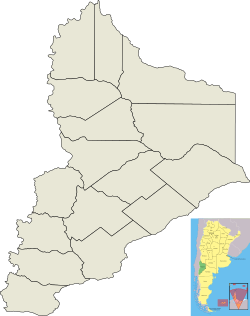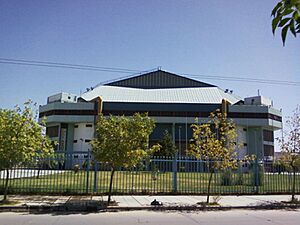Neuquén facts for kids
Quick facts for kids
Neuquén
Neuquén Capital
|
|||
|---|---|---|---|

Neuquén, Argentina
|
|||
|
|||
| Country | |||
| Province | |||
| Department | Confluencia | ||
| Founded | 1904 | ||
| Area | |||
| • City | 128 km2 (49 sq mi) | ||
| Elevation | 270 m (890 ft) | ||
| Population
(2010 census)
|
|||
| • Urban | 224,685 | ||
| Time zone | UTC−3 (ART) | ||
| CPA base |
Q8300
|
||
| Dialing code | +54 299 | ||
| Climate | BWk | ||
Neuquén is the capital city of the Argentine province of Neuquén. It is located in the eastern part of the province. The city sits where the Limay and Neuquén rivers meet, forming the Río Negro. This area is part of the Alto Valle del Río Negro region.
With over 340,000 people, Neuquén is the largest city in Patagonia. It is also part of a larger city area that includes Plottier and Cipolletti. Neuquén was founded in 1904, making it the newest provincial capital city in Argentina.
Contents
What's in a Name? The Meaning of Neuquén
The name of the city comes from the Neuquén River. In the Mapuche language, "Neuquén" means "water that has strength." This name was first used for the federal territory in 1884. Later, in 1902, it was given to the railway station in a small village called Confluencia.
The name "Neuquén" was officially chosen for the town in 1904 when it became the capital. Fun fact: Neuquén is the only Argentine city with a palindrome name! This means it reads the same backward as forward.
Neuquén's Economy: Fruits and Oil
Neuquén is important for two main reasons: agriculture and oil. The land around the city is very fertile because it is watered by the Limay and Neuquén rivers. This allows farmers to grow many crops, especially apples, pears, and other fruits.
The city is also a big center for the petrochemical industry. This means it processes oil that is dug up from different parts of the province. Recently, huge oil and gas fields called Vaca Muerta were found west of the city. These are some of the largest shale gas and oil reserves in the world! This discovery has caused a big boom in building and real estate in Neuquén. The city is expected to grow a lot because it is the main city in the region for oil and gas companies and their suppliers.
Getting Around: Transport in Neuquén
Neuquén has good ways to travel. National Route 22 (RN22) is the main road. It connects Neuquén to other parts of Argentina. This road is mostly a four-lane highway. It links the city to the Atlantic coast in Bahía Blanca to the east. To the west, it goes to Temuco in Chile, San Carlos de Bariloche, and Zapala.
The Presidente Perón Airport is about 8 kilometers (5 miles) west of the city center. It has regular flights to major Argentine cities like Buenos Aires, Córdoba, and Mendoza.
The Tren del Valle is a train service that connects Neuquén with nearby cities like Cipolletti and Plottier. Freight trains also carry goods to Bahía Blanca and Zapala.
Within the city, there are 30 bus lines. These buses connect most areas of Neuquén, including Plottier and Las Perlas. There are also buses that go to other towns in the wider area, such as Centenario and General Roca.
A Look Back: Neuquén's History
The first people in this area were very mobile. They moved around based on the seasons and where food was plentiful. Around the 16th century, the Mapuche people began to influence and mix with the local groups. An important trail used by the Mapuches passed right through where the Limay and Neuquén rivers meet.
In the 17th century, European explorers came to this area. In 1604, Hernando Arias de Saavedra explored trails to Patagonia. He reached what is now Neuquén. Later, in 1782, Basilio Villarino traveled up the Río Negro. On January 23, 1783, he arrived at the meeting point of the Limay and Neuquén rivers.
Neuquén Becomes an Argentine Province Capital
In 1885, the lands of what was then called Confluencia were sold. After a military campaign over Patagonia, the Tehuelche and Pehuenche tribes who lived in Neuquén province were moved from their lands.
Argentina did not have a clear border with Chile at that time. So, the government made a deal with a British railway company. The company would build a railway extension to the town. In return, they would get land to help people settle there. The railroad reached Cipolletti in 1899. Three years later, after a bridge was built, it arrived in Neuquén.
Neuquén was officially founded on September 12, 1904. The capital of the territory was moved from Chos Malal to this new town. The name "Neuquén" comes from the Mapudungun word nehuenken, meaning "drafty," which described the river.
By 1930, Neuquén had only about 5,000 people. In the 1960s, it became much more important. This happened when oil was found in the province by the state company YPF. The 1970s and 1980s saw a huge increase in population. New things were built, like the National University of Comahue in 1971.
Neuquén's Climate: Dry and Windy
Neuquén has a dry climate, also known as an arid climate. It doesn't rain much, only about 200 millimeters (8 inches) per year. The rain is spread out fairly evenly throughout the year. The average yearly temperature is between 14 and 15 degrees Celsius (57-59 degrees Fahrenheit).
In December and January, the average temperature is about 23 degrees Celsius (73 degrees Fahrenheit). In July, it drops to below 6 degrees Celsius (43 degrees Fahrenheit). Because Neuquén is far from large bodies of water, its temperatures can change a lot between day and night, and between seasons. This is called a high thermal amplitude.
Winds are quite strong all year. This helps dry out the land. Most of the wind comes from the west and southwest. Summers are usually windier than winters. In January, the city gets about 11 hours of sunshine per day. In June, it gets about 3 hours per day.
The hottest temperature ever recorded was 42.3 degrees Celsius (108.1 degrees Fahrenheit) on January 21, 1980. The coldest temperature recorded was -12.8 degrees Celsius (9 degrees Fahrenheit) on June 13, 1961.
| Climate data for Neuquén, Argentina (1991–2020, extremes 1900–present) | |||||||||||||
|---|---|---|---|---|---|---|---|---|---|---|---|---|---|
| Month | Jan | Feb | Mar | Apr | May | Jun | Jul | Aug | Sep | Oct | Nov | Dec | Year |
| Record high °C (°F) | 42.3 (108.1) |
41.6 (106.9) |
40.5 (104.9) |
33.1 (91.6) |
31.0 (87.8) |
28.1 (82.6) |
25.6 (78.1) |
30.7 (87.3) |
34.0 (93.2) |
35.6 (96.1) |
40.8 (105.4) |
40.8 (105.4) |
42.3 (108.1) |
| Mean daily maximum °C (°F) | 32.1 (89.8) |
30.6 (87.1) |
27.4 (81.3) |
21.8 (71.2) |
16.6 (61.9) |
13.3 (55.9) |
13.1 (55.6) |
16.1 (61.0) |
19.3 (66.7) |
22.9 (73.2) |
27.1 (80.8) |
30.3 (86.5) |
22.6 (72.7) |
| Daily mean °C (°F) | 24.1 (75.4) |
22.4 (72.3) |
19.1 (66.4) |
13.7 (56.7) |
9.5 (49.1) |
6.8 (44.2) |
6.0 (42.8) |
8.3 (46.9) |
11.7 (53.1) |
15.5 (59.9) |
19.5 (67.1) |
22.6 (72.7) |
14.9 (58.8) |
| Mean daily minimum °C (°F) | 15.9 (60.6) |
14.4 (57.9) |
11.8 (53.2) |
7.2 (45.0) |
4.0 (39.2) |
1.7 (35.1) |
0.5 (32.9) |
2.0 (35.6) |
4.8 (40.6) |
8.4 (47.1) |
11.9 (53.4) |
14.6 (58.3) |
8.1 (46.6) |
| Record low °C (°F) | 2.3 (36.1) |
2.1 (35.8) |
−5.3 (22.5) |
−4.8 (23.4) |
−10.5 (13.1) |
−12.8 (9.0) |
−11.8 (10.8) |
−10.6 (12.9) |
−7.0 (19.4) |
−2.9 (26.8) |
−0.9 (30.4) |
−3.3 (26.1) |
−12.8 (9.0) |
| Average precipitation mm (inches) | 13.5 (0.53) |
12.6 (0.50) |
14.8 (0.58) |
21.9 (0.86) |
26.4 (1.04) |
17.6 (0.69) |
17.9 (0.70) |
9.6 (0.38) |
16.5 (0.65) |
32.9 (1.30) |
17.7 (0.70) |
10.3 (0.41) |
211.7 (8.33) |
| Average precipitation days (≥ 0.1 mm) | 2.2 | 2.7 | 2.6 | 4.2 | 5.3 | 5.7 | 4.4 | 3.0 | 3.9 | 4.0 | 2.8 | 2.2 | 43.1 |
| Average snowy days | 0.0 | 0.0 | 0.0 | 0.0 | 0.1 | 0.5 | 0.4 | 0.1 | 0.1 | 0.2 | 0.0 | 0.0 | 1.4 |
| Average relative humidity (%) | 38.1 | 45.4 | 53.6 | 63.0 | 70.2 | 70.9 | 68.0 | 58.8 | 51.1 | 46.5 | 39.9 | 37.2 | 53.6 |
| Mean monthly sunshine hours | 322.4 | 299.5 | 263.5 | 207.0 | 148.8 | 117.0 | 148.8 | 176.7 | 189.0 | 248.0 | 279.0 | 282.1 | 2,681.8 |
| Mean daily sunshine hours | 10.4 | 10.6 | 8.5 | 6.9 | 4.8 | 3.9 | 4.8 | 5.7 | 6.3 | 8.0 | 9.3 | 9.1 | 7.4 |
| Percent possible sunshine | 69.3 | 76.3 | 66.7 | 65.0 | 48.3 | 42.0 | 44.3 | 55.3 | 54.0 | 63.3 | 66.0 | 60.0 | 59.2 |
| Source 1: Servicio Meteorológico Nacional | |||||||||||||
| Source 2: Secretaria de Mineria (percent sun 1961–1990), Meteo climat (record highs and lows 1900–present) | |||||||||||||
Culture and Art: Museums and Landmarks
Neuquén has many cultural places. Some are in old railroad buildings from the early 1900s. These include the Gregorio Álvarez Provincial Museum and the Paraje Confluencia museums. There is also the Emilio Saraco Art Gallery.
The Museo Nacional de Bellas Artes is a newer building. It opened in 2004 and was designed by Mario Roberto Alvarez. This museum shows art from both Argentine and international artists. It has four halls for both temporary and permanent art collections. There is also an auditorium and a theater. You can also find historical monuments around the city. One example is the Fotheringham Crossing Pyramid in the Sapere neighborhood.
Sports in Neuquén
Neuquén is a city that loves sports! It hosted the 2001 FIBA Americas Championship, a big basketball tournament. The city's fans cheered on Argentina's national basketball team to win the gold medal. All the games were played at the Estadio Ruca Che, which can hold 8,000 people. Neuquén also helped host the 1995 FIBA Americas Championship.
Since 2015, Neuquén has hosted the FIM Motocross World Championship. The motocross track in Villa La Angostura was even voted the best of the season for two years in a row!
Sister Cities
Neuquén has "sister city" relationships with other cities around the world. This means they share cultural ties and promote friendship. Neuquén's sister cities are:
See also
 In Spanish: Neuquén (ciudad) para niños
In Spanish: Neuquén (ciudad) para niños






